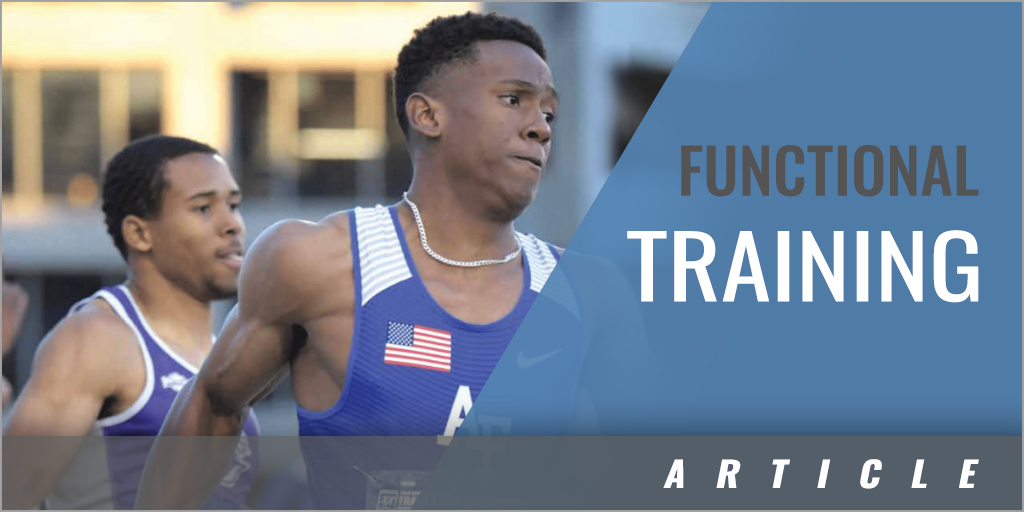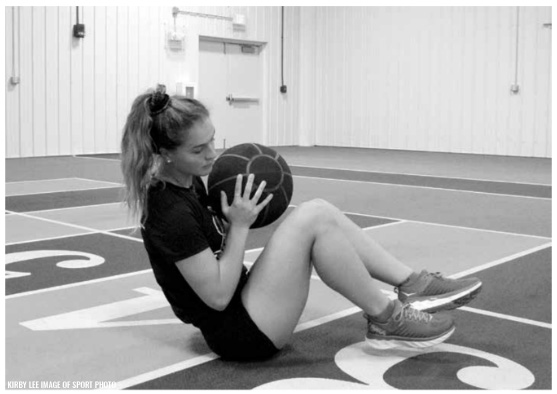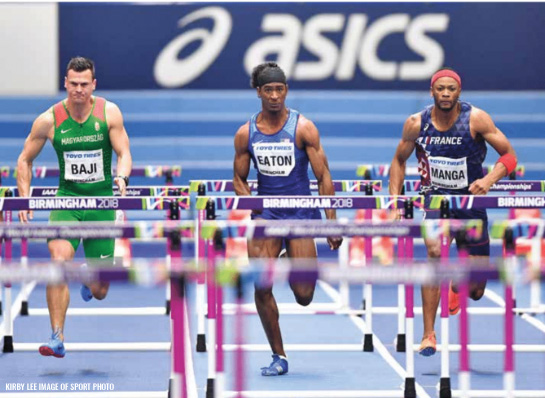|
By: Mike Thorson Originally Published in: Techniques Magazine Provided by: USTFCCCA There are many, many training protocols that coaches can employ outside of the traditional weight room to develop strength and power for sprinters and hurdlers. Many coaches would call this supplementary training. But it is not supplementary - it is a critically important and essential component in the training of a sprinter or hurdler.
Many authorities refer to this training as functional training. This is a term that has negative connotations for a lot of coaches because there is a lack of understanding of what functional training is, and because it often goes against conventional thinking surrounding training. There are many misconceptions involved with this type of training, and many coaches are very uncomfortable when training is taken from the weight room. But the reality is this: they shouldn't be threatened at all. Functional training is not meant to replace strength training. Functional training and strength programs should work hand in hand to develop strength and explosive power in sprinters and hurdlers. So...what is functional training? Vern Gambetta defines it as this: "Training that incorporates a full spectrum of training designed to elicit the optimum adaptive response appropriate for the sport or activity being trained." Gambetta, an author, clinician, one-time track and field coach and former NBA and MLB strength and conditioning coach, is considered the "Godfather" of functional training. He goes on to say: "It means training the respective muscle groups and involved areas to work in the same manner as they are used in the activity."
In other words, it is sport specific training that can, in the case of sprinters and hurdlers, increase strength and explosive power. It is the latter that most coaches and athletes are really concerned with. Strength is the ability to exert force without regard to the time it takes to produce that force. Although there are many methods of gaining strength, it is primarily gained in the weight room and athletes obviously need a base of strength. Power, however, is the ability to exert a great amount of force in the shortest possible time. Or as Gambetta says in his book Gambetta Method (A Common Sense Guide to Functional Training for Athletic Performance), "Power is the ability to apply strength in the time frame required by the specific sport." What many coaches term strength is actually power. Nearly all athletic performances demand power-high force production in a short period of time. Strength, speed and agility are really what make up power in layman's terms. Functional training does an excellent job of training power because it trains true athleticism, which is often lacking in many of today's training programs. Athleticism, according to Gambetta, "is the ability to execute a series of movements at optimum speed with precision, style, and grace. " The basis of training athleticism is human movement - running, jumping and throwing. And that in a nutshell is what functional training is all about. The body is a "link" system and all parts have to work in sync to produce efficient patterns of movement. Functional training trains movements or movement patterns and not muscles, as often is the case in the traditional weight room. It is dependent on coaches to develop athleticism. That is what functional training is all about. It involves training in all planes of movement, employing multi-joint actions, and it has a high proprioceptive demand. Oftentimes, training that occurs in the typical weight room does not involve all the planes of movement. It trains single joint movements and there is quite often not a high proprioceptive demand.
CORE TRAINING Functional training begins with the core - the center of the body where all powerful movements are initiated. The core includes the muscles of the hips, abdomen and lower back. Gravity, posture and balance are all controlled by muscles of the core. Despite the importance of the core in the kinetic chain, it is often neglected or incorrectly trained. Core training should train multi-plane movements that are functional and synergistic. Although sit-ups and ab circuits are great core activities, there are many, many more core exercises. Most authorities would say the best core exercises are ones that include standing, upright exercises that involve a combination of flexion, extension and rotation and work a full range of motion through the movement. A couple of our favorites: Over and Under (Partner with med ball) - Stand with feet hip-width apart, knees slightly bent, with your partner right behind you and the med ball out in front of you. The athlete lifts the ball Duck Walk - Start with your feet shoulder-width apart and squat into a position like you are sitting in a very low chair, keeping your torso long and wide. You can walk forward or backward, making sure that the entire foot takes off and lands flat beneath the torso on each step. FUNCTIONAL TRAINING BENEFITS There are many benefits to training functionally. In addition to the core, there are four major areas that functional training can benefit: Balance - Balance is the single most important component in athletic ability, and it is often neglected in training. Functional training deals with dynamic balance, with athletes repeatedly losing and regaining control of their center of gravity. It is critically important in sprinting, with the athlete alternating balancing on one leg and then the other in less than a tenth of a second. It is a skill, like most other athletic skills, that must be trained on a regular basis. There is balance equipment such as K-boards, mini-tramps and foam blocks, just to name Posture - This is how an athlete holds the body, and functional training can improve an athlete's ability to maintain proper posture in all different positions and planes of movement. Good posture is a must for sprinters. It allows them Stability - Athletes must possess the ability to keep joints in line with the direction of the force being applied. Functional training does an excellent job of training this because it is constantly challenging the joint's ability to Mobility - Defined as range of motion for the joints of the body through which force can be applied, functional training demands a sound range of motion in all desired directions of movement. Many
TYPES OF FUNCTIONAL TRAINING There are many types of methodologies that can be termed "functional training." We have already addressed two: Core training and Balance. Most of We will take a quick look at both plyometric and circuit training and outline some of the training we are using in our program at the University of Mary. PLYOMETRIC TRAINING Plyometrics are exercises in which muscles exert maximum force in short intervals of time to train the effectiveness of the stretch shortening cycle, with the goal of increasing explosive power. They are very important in increasing power by improving an athlete's ability to mix strength, speed and agility with the use of their own body weight. Coaches need to understand that the goal of plyometrics is to improve the relationship between maximum strength and explosive power. It is Another factor that coaches must consider is the training loads and time needed to recover from plyometric exercises. Low stress plyometrics require very little recovery. High stress exercises such as depth jumps can require up to three days! The weight of the athlete, volume, intensity, displacement of the center of gravity (vertical or horizontal, or both), and speed of the exercise should be taken into consideration to determine the appropriate training loads and recovery time. Coaches must also demand that plyometric drills are properly executed. One of the keys to safe, effective injury-free plyos comes with the correct landing with an upright posture. The shock of the landing should not be absorbed just by the foot, but by a combination of the ankle, knee and hip to transfer the force to the muscles of the body. The foot strike should be on the entire foot and not the heel or ball of the foot. An incorrect foot strikes causes the forces to be absorbed by the bones of the foot, knee and hip, and not the muscles of the body. An upright posture will assist in eliminating lower back stress and injuries. The progression of the program is important too, with the coach beginning with low impact exercises before advancing to the high-stress activities that will produce greater forces on the body. Our program includes plyometric drills nearly every day, with the exception being recovery days. Our warmup includes plyometric exercises, as do our regular training sessions for sprinters and hurdlers. A couple of plyo exercises that we frequently employ are hurdle hops and standing long jumps. We quite frequently include these types of plyometric drills in our regular workouts.
A couple of plyometric routines used by Mary hurdlers: **Orange Multi Jump/Throw Plyometric Circuit with Med Ball (10-20 throws depending on athlete and time of the year)
**Blue Multi Jump/Throw Plyometric Circuit (20 Throws depending on athlete and time of the year)
CIRCUIT TRAINING Circuit training is a series of strength and fitness exercises where an athlete moves from station to station in a pre-determined order or sequence. The two primary goals of circuit training are to develop strength endurance and work capacity. Coaches should always keep in mind that strength and proper technique should come before strength endurance prior to beginning and designing circuit training. The exercises must be mastered before the strength endurance component is implemented. Often, coaches will begin strength training programs with circuits, and the athletes do not have the proper strength levels to safely do the circuits without injury. We have included several of our circuits that we use in our program. Most of our circuits include plyometric exercises and could also fall into the plyo category of training: **Marauder Hurdle Hop/High Knee Circuit
**Pirate Conditioning Circuit Number 2 (Outdoors)
**Mary Squat Thrust/Pushup Circuit
**Mary Marauder Hill Circuit (Outdoors)
FUNCTIONAL TRAINING VS. Some coaches continue to be skeptical of functional training. "Why do you Many athletes become very strong in the weight room, but they cannot apply that strength to athletic performance. The Jamaican athletes that our program has had over the years are an excellent SUMMARY Functional training is not supplementary training. It should and can work side-by-side with the traditional strength programs. If coaches understand the biomechanics of function and movement and are creative and innovative, they will be able to blend the two together to implement successful training programs for sprinters and hurdlers that build strength and explosive power. REFERENCES Gambetta, Vern, Gambetta Method, A Common Sense Guide to Functional Training for Athletic Performance, Second Edition, Gambetta Sports Training Systems, 2002 McFarlane, Brent, The Science of Hurdling and Speed, Fourth Edition, Athletics Canada, 2000 Radcliff, James, Functional Training for Athletes of All Levels, Ulysses Press, 2007 MIKE THORSON IS CURRENTLY AN ASSISTANT COACH UNIVERSITY OF MARY, WHERE HE OVERSEES THE HURDLE EVENTS. HE IS THE FORMER DIRECTOR OF TRACK & FIELD AND CROSS COUNTRY AT THE UNIVERSITY OF MARY AND HAS BEEN A REGULAR CONTRIBUTOR TO TECHNIQUES. |











